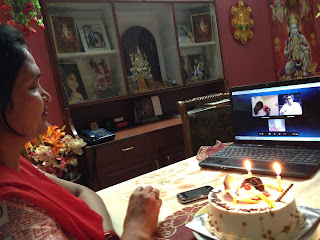Traveling outside of Udaipur (the main city) as foreigner that speaks little Hindi can be a daunting task which can also limit the amount of sites you're able to see. However the group of students I was with was always down for an adventure which made it easy to get out an explore. One member of our group had her host family arrange a van for us one Sunday so we all chipped in to pay for the van and set out for an excursion to Ranakpur & Kumbhalgarh. Upon getting in the van I really was unaware of where we were going I just knew that one was a temple and the other was a fort. Nevertheless I was open for the experience (as I was with most of my excursions in India).
Upon arriving to the first destination (Ranakpur Jain Temple) my eyes were greeted with beautiful green shrubbery, monkeys, and of course the usual stares from various local people. Ranakpur Jain Temple is famous for its excellent sculptures and architecture. Surrounded by the Aravali hills and located on the banks of 'Magai' river this grand & gigantic four facet structures was erected in the 14th Century. The Temple is three storied, 102 ft. high and its spread over an area of 48000 sq. ft. The present structure of the temple came into being after 50 years of work by various artisans & sculptors. The land of this temple which situated at the foot hill of 'Madri hills' was gifted by Maharana Kumbha of Mewar. Along with this temple a small town, about 2 kms. from the temple also came into existence. this town got its name from 'Rana' & was named 'Ranpur' which later came to be known as 'Ranakpur'. The temple is dedicated to the first Jain Teerthkar 'Lord Adinath'. it is built on high platform, which has about nine basement. it has 84 idols of gods and demi gods., 1444 pillars elaborately and beautifully decorated along with 4 'Megh Mandaps'. surrounding the main temple there are small shrines of Lord 'Parshwanath','Neminath'& 'Surya Narayan'.
The pictures do this temple no justice! Initially I wasn't going to blog about this because I wanted to keep some of my experiences personal and scared. However, after visiting a second time when my father came I decided to share. Bliss and awe are the only two words I can use to describe my experience in the temple my first visit to the temple my group of friends and I were greeted by a Jain priest and offered a tour of the temple in which he offered an explanation Jainism and the overall significance of various sculptures in the temple. Once our tour concluded we were offered to meditate with the head priest of the temple. That experience was one of the most serene feelings I ever felt after leaving the Jain temple that day I was truly in the moment and at peace with all things in my life.
Due to the amazing experience I had the first time I went visiting the Ranakpur Jain temple it was something I had to share with my Dad when he came to visit and thats exactly what we did! My Dad was in as much awe and wonder as I was when I was there my first time. Once we entered the temple we had the walk around again with a different priest although we did not meditate. We went our separate ways and took in the massive beauty of the temple in its surroundings. I can always tell when my Dad is amazed by something because he becomes very quite and observant. I was so happy to share the temple with my Dad as an experience to add to our memories.
This blog about Ranakpur truly does not do it any justice! If you ever find yourself in Udaipur I highly recommend going to this temple to see it with your own eyes!
Sidenote: The temple provides housing accommodations and food for a very cheap price (if your backpacking or like staying in local accommodations. The temple also provides daily lunch for a small fee as well I don't remember the times, but it was pretty good and you get to sit with local priest and community members its a great way to immerse yourself in the culture.
*sources: http://www.ranakpurhillresort.com/ranakpur-jain-temple.htm






















































